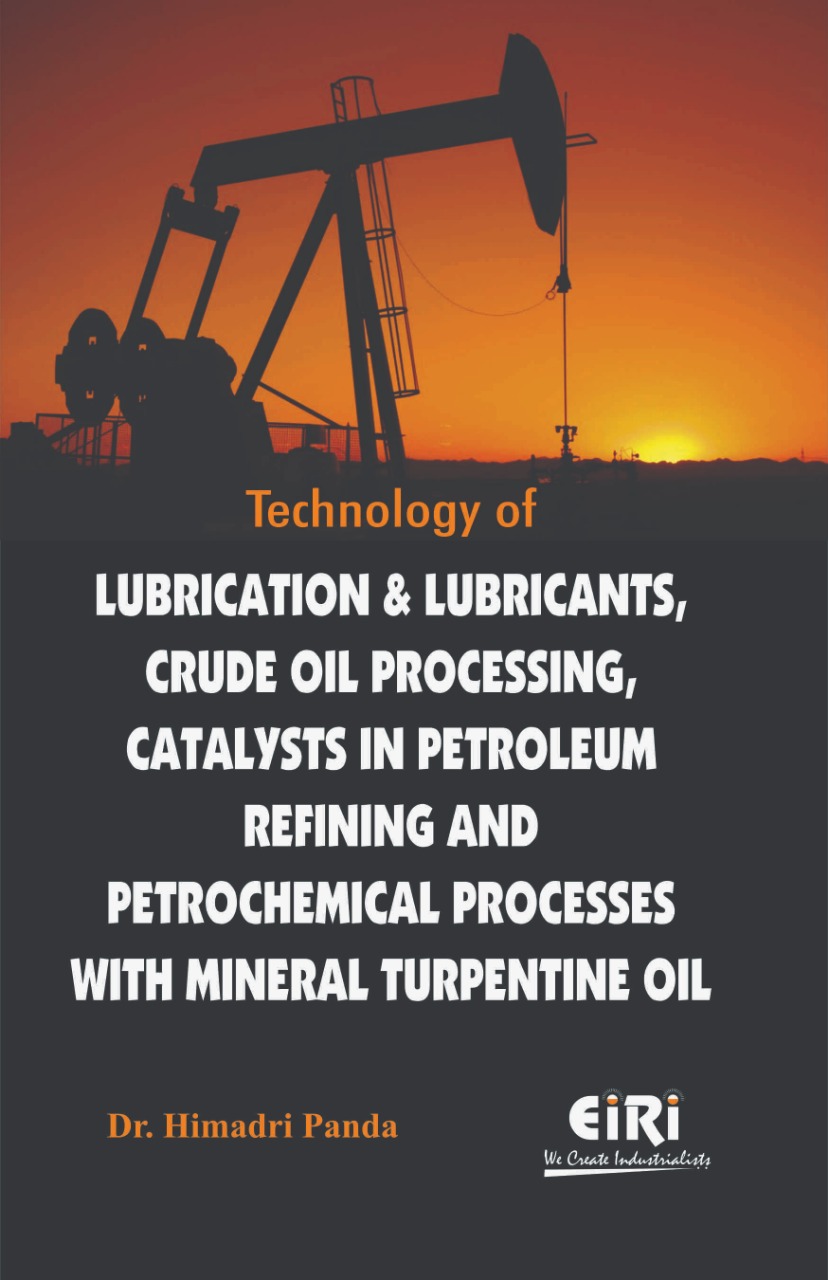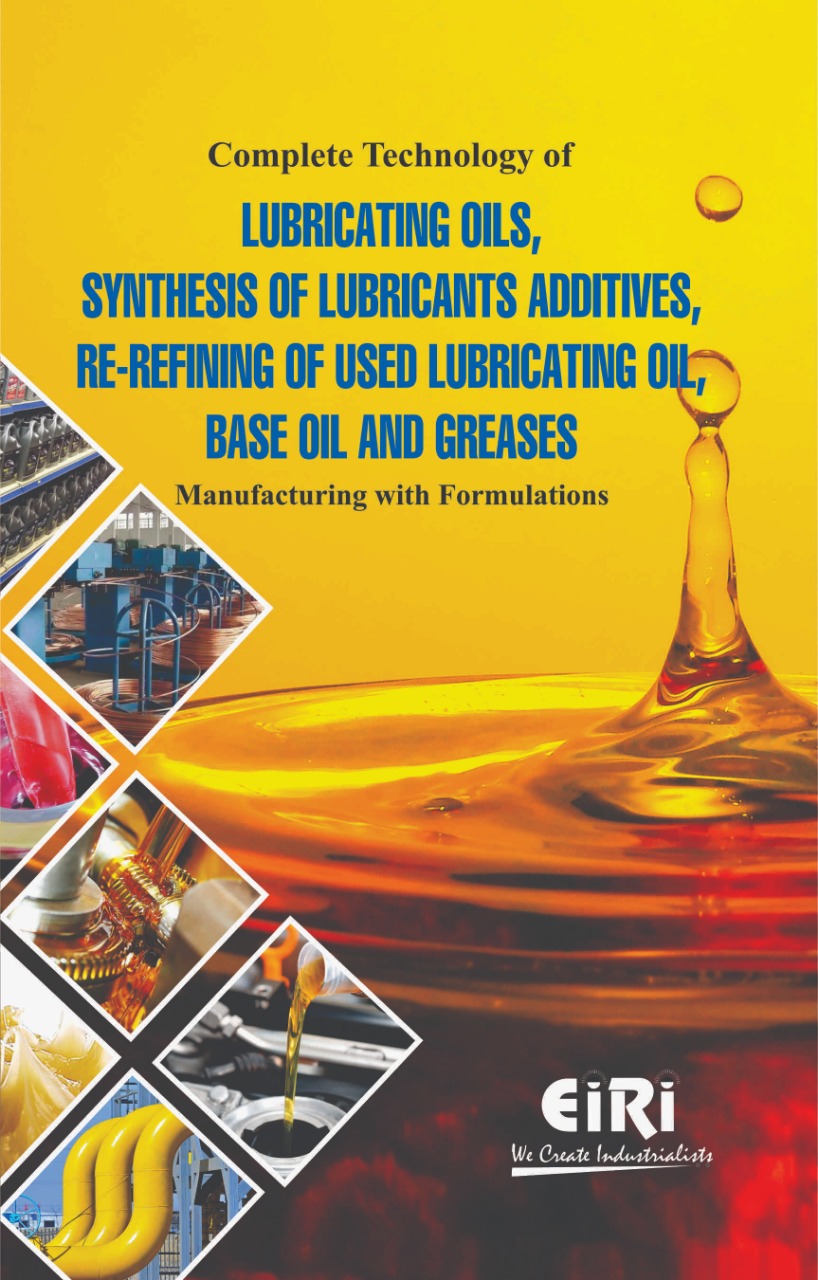Description
Contents:
Lubrication and Lubricants
- Functions of Lubricants
- Lubrication Principles
- Tests of Lubricants
- Lubricants of Mineral Origin
- Synthetic Lubricants
Benzene
- Manufacturing Process From Petroleum by
- Catalytic Reforming
Ethylene
- From Refinery Gas by Thermal Cracking
Monoethylene Glycol
Diethylene Glycol
Triethylene Glycol
- Monoethylene Glycol From Ethylene and Oxygen
- Uses
- Grades
- Toxicity
Ethylene Oxide
- Molecular Formula
- Properties
- Manufacturing Process
- From Ethylene and Oxygen
- Raw material requirement
Toluene
- Properties
- Manufacturing Process
- From Petroleum by Hydroforming
- Raw material requirement
Xylene
- Properties of Xylene Isomers
- Manufacturing Process
- Form Petroleum by Catalytic Reforming or
- hydroforming
Petroleum jelly
- Physical properties
- Comparison with glycerol
- Uses
- Medical treatment
- Skin and hair care
- Preventing moisture loss
- Hair grooming
- Skin lubrication
- Product care and protection
- Coating
- Finishing
- Lubrication
- Production processes
- Tattooing
- Explosives
- Mechanical, barrier functions
- Surface cleansing
- Pet care
- Clean-up
- Properties of Petroleum Jelly
- Skin Care
- Face Care
- Hair Care
- Nail Care
- Household Needs
Bioethanol Production From Sugar Cane Molasses
- Ethanol
- Feedstock for bioethanol production
- Sucrose-containing feedstocks
- Starchy materials
- Lignocellulosic biomass
- Ethanol from cane molasses
- Processes of ethanol production
Production of Bio-ethanol from Molasses by Schizosaccharomyces Species
- Introduction
- Materials And Methods
- Collection of Samples
- Isolation of Schizosaccharomyces
- Production of Ethanol from Molasses
- Identification of the Microorganisms
- Originally Present in Molasses
- Inoculation of Molasses by Isolated Yeast
- Distillation and Detection of Ethanol
- Results And Discussion
- Isolation of Schizosaccharomyces
- Species
- Physical Characteristics of the
- Molasses Sample
- Microorganisms Originally Present
- in Molasses
- Production of Ethanol from Raw
- Molasses
- Production of Ethanol from Molasses
- with Different Concentrations of Sucrose
- Detection of Ethanol
Petroleum Crude Oils
- Composition of Crude Oils
- Hydrocarbon Compounds
- Alkanes (Paraffins)
- Cycloparaffins (Naphthenes)
- Aromatic Compounds
- Non-hydrocarbon Compounds
- Sulfur Compounds
- Acidic Sulfur Compounds
- Non-acidic Sulfur Compounds
- Nitrogen Compounds
- Basic Nitrogen Compounds
- Non-Basic Nitrogen Compounds
- Oxygen Compounds
- Acidic Oxygen Compounds
- Non-Acidic Oxygen Compounds
- Metallic Compounds
- Density, Specific Gravity and API Gravity
- Salt Content
- Sulfur Content
- Pour Point
- Ash Content
Crude Oil Processing
- Physical Separation Processes
- Atmospheric Distillation
- Vacuum Distillation
- Absorption Process
- Adsorption Process
- Solvent Extraction
- Conversion Processes
- Thermal Conversion Processes
- Coking Processes
- Thermal Cracking Reactions
- Delayed Coking
- Fluid Coking
- Viscosity Breaking (Vis-breaking)
- Catalytic Conversion Processes
- Catalytic Reforming
- Reformer Feeds
- Reforming Catalysts
- Reforming Reactions
- From Acetylene and Acetone
- From Isobutylene and Formaldehyde (IFP Process)
- From Isobutylene and Methylal (Sun Oil Process)
- From Propylene (Goodyear Process)
Chemicals Based on Methane
- Chemicals Based On Direct Reactions of Methane
- Carbon Disulfide (CS)
- Uses Of Carbon Disulfide
- Hydrogen Cyanide (Hcn)
- Chloromethanes
- Production of Chloromethanes
- Uses of Chloromethanes
- SYNTHESIS GAS
- CHEMICALS BASED ON SYNTHESIS GAS
- AMMONIA (NH)
- Uses of Ammonia
- Nitric Acid (HNO)
- Hydrazine (HN-NH).
- Methylalcohol (CHOH)
- Production of Methanol
- Uses of Methanol
- Methyl Chloride (CHCI)
- Acetic Acid (CHCOOH)
- Methyl Tertiary Butyl Ether ((CH)C-O-CH)
- Dimethyl Carbonate (CO(OCH))
- Methylamines
- Ethylene Glycol
Ethane and Higher Paraffins-Based Chemicals
- Ethane Chemicals
- Propane Chemicals
- Oxidation of Propane
- Nitration of Propane (Production of Nitroparaffins)
- N-butane Chemicals
- Oxidation of N-butane (Acetic Acid and
- Acetaldehyde)
- Maleic Anhydride:
- Aromatics Production
- Isobutane Chemicals
- Naphtha-based Chemicals
- Chemicals From High Molecular Weight
- N-paraffins
- Oxidation Of Paraffins (Fatty Acids And Fatty
- Alcohols)
- Chlorination Of N-paraffins (Chloroparaffins)
Chemicals Based On Ethylene
- Introduction
- Oxidation Of Ethylene
- Derivatives of Ethylene Oxide
- Ethylene Glycol (CHOHCHOH)
- Ethoxylates
- Ethanolamines
- ,-Propanediol
- Acetaldehyde (Chcho)
- Important Chemicals From Acetaldehyde
- Acetic Acid
- N-butanol
- Oxidative Carbonylation of Ethylene
- Chlorination of Ethylene
- Vinyl Chloride (Ch=Chcl)
- Linear Alcohols
Chemicals Based on Propylene
- Oxidation of Propylene
- Acrolein (CH=CHCHO)
- Uses of Acrolein
- Ammoxidation Of Propylene
- (Acrylonitrile [CH=CHCN])
- Uses of Acrylonitrile
- Adiponitrile (NC(CH)CN)
- Deriatives and Uses of Propylene Oxide
- Propylene Glycol (CHCH(OH)CHOH)
- Allyl Alcohol (CH=CHCHOH)
- Oxyacylation of Propylene
- Chlorination of Propylene
- (Allyl Chloride [Ch=Chchcl])
- Hydration of Propylene
- (Isopropanol [Chchohch])
- Properties And Uses of Isopropanol
- Acetone Production
- Propertles and Uses of Acetone
C4 Oleffins and Diolefins- Based Chemicals
- Introduction
- Chemicals From N-butenes
- Oxidation of Butenes
- Acetic Acid CHCOH
Chemicals Based on Benzene, Toluene, and Xylenes
- Reactions and Chemicals of Benzene
- Reactions and Chemicals of Toluene
- Oxidation of Toluene
- Caprolactam Production
- Phenol from Benzoic Acid
- Terephthalic Acid from Benzoic Acid
- Chlorination of Toluene
- Nitration of Toluene
- Carbonylation of Toluene
- Chemicals From Xylenes
- Terephthalic Acid (Hoocc6h4cooh)
Synthetic Petroleum-Based Polymers
- Introduction
- Thermoplastics And Engineering Resins
- Polyethylene
- Low-Density Polyethylene
- High-Density Polyethylene
- Linear Low-Density Polyethylene
- Properties and Uses of Polyethylenes
- Polypropylene
- Copolymerization
- Properties and Uses of Polypropylene
- Properties and Uses of Polyvinyl Chloride
- Properties and Uses of Styrene Polymers
- Nylon Resins
- Thermoplastic Polyesters
- Polycarbonates
- Properties and Uses of Polycarbonates
- Polyether Sulfones
- Properties and Uses of Aromatic Polyether Sulfones
- Poly(phenylene) Oxide
- Polyacetals
- Thermosetting Plastics
- Polyurethanes
- Properties and Uses of Polyurethanes
- Epoxy Resins
- Properties and Uses of Epoxy Resins
- Unsaturated Polyesters
- Phenol-formaldehyde Resins
- Properties and Uses of Phenolic Resins
- Amino Resins (Aminoplasts)
- Urea-Formaldehyde and Urea-Melamine Resins
- Properties and Uses of Aminoplasts
- Polycyanurates
- Synthetic Rubber
- Butadiene Polymers And Copolymers
- Properties and Uses of Polybutadiene
- Styrene-Butadiene Rubber (SBR)
- Nitrile Rubber (Nbr)
- Polyisoprene
- Properties and Uses of Polyisoprene
- Polychloroprene (Neoprene Rubber)
- Butyl Rubber
- Ethylene-propylene Rubber
- Transpolypentamer
- Thermoplastic Elastomers
- Synthetic Fibers
- Polyester Fibers
- Polyethylene Terephthalate Production
- Properties and Uses of Polyesters
- Polyamides (Nylon Fibers)
- Nylon (Polyhexamethyleneadipate)
- Nylon (Polycaproamide)
- Nylon (Polylaurylamide)
- Nylon (Polybutyramide)
- Nylon (Polyundecanylamide)
- Other Nylon Polymers
- Properties and Uses of Nylons
- Acrylic And Modacrylic Fibers
- Properties and Uses of Polyacrylics
- Carbon Fibers (Graphite Fibers)
- Polypropylene Fibers
Catalysts in Petroleum Refining and Petrochemical Processes
- Introduction
- Homogeneous and Heterogeneous Catalysts
- Catalyst Morphology and Activity
- Catalysts for Petroleum Refining
- Cracking Catalysts
- Reforming Catalysts
- Hydrotreating Catalysts
- Catalysts For Petrochemicals Industry
- Catalysts For Synthesis Gas
- Hydrogenation Catalysts
- Hydrocarbon Oxidation Catalysts
- Polymerization Catalysts
- Recent Advances in Industrial Catalysis
- Dual-Function Catalysts
- Super-Active Metal Catalysts
- Supported-Ziegler Catalysts
- Advances in Homogeneous Catalysis
- Role of Polymers in Catalysis
Petrochemicals Future
- Integrated Petrochemicals Complex
- Natural Gas As Petrochemical Feedstock
- Impact Of Heavy Feedstocks
- On Petro-chemicals
- Ecology And The Energy Crisis
- Coal As An Alternative To Oil
- Energy Crisis and the Industrial Fuels
- Natural Fuels
- Synthetic Fuels
- Hydrogen: Fuel for tomorrow
- Trends in Petrochemical Industry
- Development in Cracking Technology
- Olefins Vs Paraffins
- Prospect for Propylene
- Size of Plant
- Biomass: Renewable Resource for Petrochemicals
- Waste Disposal
Plant Economics of Mineral Turpentine Oil (MTO)
- Plant & Machinery
- Fixed Capital
- Raw Materials
- Total Working Capital/Month
- Total Capital Investment
- Turn Over/Annum
Plant Economics of Lubricating Oil (20w40 Grade Sn-Type)
- Plant & Machinery
- Fixed Capital
- Raw Materials
- Total Working Capital/Month
- Total Capital Investment
- Turn Over/Annum
Plant Economics of Oil Re-refining Unit
- Plant & Machinery
- Fixed Capital
- Raw Materials
- Total Working Capital/Month
- Total Capital Investment
- Turn Over/Annum
Plant Economics of Crude Oil Refining
- Plant & Machinery
- Fixed Capital
- Raw Materials
- Total Working Capital/Month
- Total Capital Investment
- Turn Over/Annum
List of Tables
Table : Properties and uses of various types of greases
Table : Specification for Commercial Grades of Benzene
Table : Typical specification for polymer-grade ethylene
Table : Specifications of Technical Grades of
Ethylene Glycol
Table : Specification for Technical Grade Diethylene
Glycol and Triethylene Glycol
Table : Commercial specifications of Industrial Xylene
Table : Type of feedstock
Table : Physical properties of Ethanol
Table : Different feedstock for bioethanol production and their comparative production potential.
Table : Main components of cane black strap molasses
Table : Microbiological analysis of sugarcane
molasses
Table : Production of ethanol and pH value from raw molasses
Table : Production of ethanol and pH value from molasses with different concentrations of sucrose
Table : Heating values of methane and heavier hydrocarbons present in natural gas
Table : Typical analysis of some crude oils
Table : Approximate ASTM boiling point ranges for
crude oil fractions
Table: Types of petroleum cokes and their end uses
Table : Major thermoplastic polymers
Table : Important properties of polyethylenes
Table : Properties of Polypropylene
Table : Properties of polycarbonates compared with
some thermoplastics
Table : Selected properties of some elastomers
Table : Important properties of polyesters
Table : Melting points of various nylons and the
monomer formula
Table : Physical properties of fiber-grade
polypropylene
Table : Characteristics of Typical Catalysts used in Petroleum Refining.
Table : Important Catalytic Processes of Refining
and Petrochemical Industry
Table : Major Catalysts in use in IPCL Plants
Table : Industrially Important Free-Racial
Polymerization Catalysts
Table : Ziegler-Type Catalysts used in Polymer
Manufacture
Table : HOPE Catalysts.
Table : Miscellaneous Catalysts used In Polymer
Industry.
Table : Relative Cost of Ethylene Production from
Various Feedstocks
Table : Octane Number of Aromatics.
Table : Calorific Value of Fuels.
Table : Comparative Cost of Production of Various
Fuels.
Table : Sources of Hydrogen.
Table : Yield Pattern from a High Severe Cracking
Furnace.
Table : Comparative Study of Propane and
Propylene Routes to Acrylonitriie
List of figures
Fig Fluid film formation in bearing
Fig : Ethanol structure
Fig : Sugar refinery process
Fig.: Enzymatic hydrolysis of starch to glucose.
Fig. : Flow chart of ethanol production from cereal
grains.
Fig. Culture characteristics of Schizosacc-
haromyces species
Fig. Microscopic appearance of Schizosacc-
haromyces species using Gram stain technique
Fig. KMnOH+ before addition of sample (a),
Reduction of KMnOH+ to colourless after
addition of sample (b)
Fig. KCrOH+before addition of
sample (a), KCrOH+after addition change
into colour (b)
Fig. Iodine reagent before addition sample (a),
addition of sample and heating, colour of iodine
change into blue colour (b) and when cooling in water
and added NaOH, the reaction formed yellow colour
precipitate
called iodo-form (c)
Fig Flow diagram of atmospheric and vacuum
distillation units: (,) heat exchangers; () desalter,
(,) heater; () distillation column, () overhead
condenser, (-) pump around streams, () vacuum
distillation heater; () vacuum tower.
Fig Important chemicals based on methane,
synthesis gas, ammonia, and methanol.
Fig A block flow diagram showing the combined
reforming for methanol synthesis.
Fig The Haldor Topsoe and Nippon Kasei
process for producing formaldehyde: () blower,
() heat exchanger, () reactor, () steam boiler,
() absorber, (,) coolers, () incinerator, () heat
recovery, () methanol evaporator, () boiler
feed water.
Fig Major chemicals based on ethylene.
Fig Important chemicals based on propylene.
Fig . Important chemicals based on benzene.
Fig . The reaction scheme for o-xylene to phthalonitrile
Fig The Union Carbide Unipol process for producing
Fig The Union Carbide gas-phase process for gh
producing polypropylene: () reactor, () centri-
fugal compressor, () heat exchanger, () product
discharge tank (unreacted gas separated from product),
() impact reactor, () compressor, () heat exchanger,
() discharge tank (copolymer separated from reacted
gas).
Fig Polyvinyl chloride
Fig The European Vinyls Corp. process for
producing polyvinyl chloride using suspension polymeri-
zation : () reactor, () blow-down vessels (to
separate unreacted monomer), () stripping column,
() reacted monomer recovery, () slurry centrifuge,
() slurry drier.
Figure The Lummus Crest Inc. process for
producing polystyrene: () reactor, () holding
tank (Polystyrene beads and water), () centrifuge,
() pneumatic drier, () conditioning tank, () screening of
beads, (,) lubrication and blending, () shipping product.
Figure The comparative thickness for the same
degree of insulation (dry conditions).
Figure A process for producing ,-polyisoprene
(>%) by a continuous solution polymerization.
Figure The Inventa AG Process for
producing polyethylene-terephthala
Figure The Inventa-Fisher process for producing
nylon from caprolactam: () Melting station, (, )
polymerization reactors, () extruder, () intermediate
vessel, () extraction column, (,) extraction
columns, () cooling silo.





